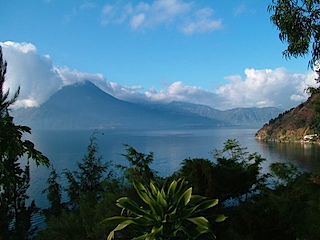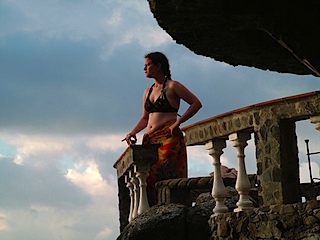What does Chalio spy? The Richardsons! 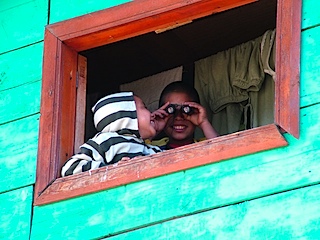 Now that the hectic visit of my in-laws is over, and I can write a little about what’s been keeping me so busy this week that I didn’t post anything.
Now that the hectic visit of my in-laws is over, and I can write a little about what’s been keeping me so busy this week that I didn’t post anything.
Emily comes from a big family: she has 7 siblings. Being friendly and loving children, the kids decided last Christmas that the best present they could give their parents would be to pool their money together and buy mom & dad a vacation in Guatemala! With a bit of hurried planning and several phone calls, we had a week of fun all set up for them. But we soon realized that one week doesn’t equal much touring in Guatemala: the long travel times in this tiny country eat up so much of the agenda. “We’d love to have you in our village, but it’s REALLY out of the way. If you come, it will take more than half the time you’ve got,” we told them. “So if you want to skip it, we understand and will not be offended at all.”
Their reaction was about the same as my aunts several months ago: “Why on earth would we come to Guatemala and NOT see your village?”
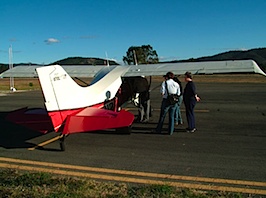 Now I’d like to say that we set up all the arrangements for them, but Mike (Emily’s dad) did a bunch of footwork himself. He’s active in Rotary and several other charitable pursuits, and is one of those people that can call up anyone and chat away. It wasn’t long before he’d set up several fun things of his own, including a flight in a bush plane from Guatemala City’s international airport to Huehuetenango’s tiny airstrip. I’m going to post more about that later, but here’s a picture of them coming to a halt in front of the little terminal building, trading 7 hours of hard bus travel for 40 minutes of scenic views by air. The vacation was on!
Now I’d like to say that we set up all the arrangements for them, but Mike (Emily’s dad) did a bunch of footwork himself. He’s active in Rotary and several other charitable pursuits, and is one of those people that can call up anyone and chat away. It wasn’t long before he’d set up several fun things of his own, including a flight in a bush plane from Guatemala City’s international airport to Huehuetenango’s tiny airstrip. I’m going to post more about that later, but here’s a picture of them coming to a halt in front of the little terminal building, trading 7 hours of hard bus travel for 40 minutes of scenic views by air. The vacation was on!
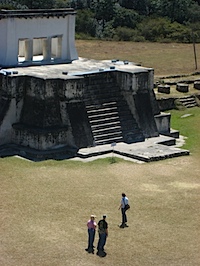 Based on our previous success with my aunts, we talked to Mario, our buddy that has a microbus, and chartered his services for the final leg of the journey to our village. Mario’s a cool, pleasant fellow. But he’s also a really conscientious driver, and got us everywhere in a safe and timely manner. We even stopped at the ruins of Zacaleu, a trip made infinitely more convenient when you a vehicle at your disposal.
Based on our previous success with my aunts, we talked to Mario, our buddy that has a microbus, and chartered his services for the final leg of the journey to our village. Mario’s a cool, pleasant fellow. But he’s also a really conscientious driver, and got us everywhere in a safe and timely manner. We even stopped at the ruins of Zacaleu, a trip made infinitely more convenient when you a vehicle at your disposal.
Several hours later we arrived in our village. As luck would have it, there was a big marimba fiesta in the community room. They were celebrating the opening day of the new long-distance high school class in the village school. Mike and Mille hardly had time to set down their jackets before they were drawn into the dancing, eating, and merrymaking.
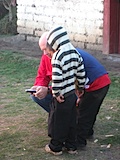 In the days to come, they spent time in the village meeting the people that are important to us, talking to the locals, thanking them for being so supportive. Mike really hit it off with Chalio and Alberto, who were over at our house almost nonstop. Mike brought with him all sorts of gadgets that the kids couldn’t get enough of: binoculars, a laser pointer, even a handheld GPS unit (which he is demonstrating to Alberto in the photo to the right). At one point, Chalio carried over some toy airplanes and helicopters that he made from cornstalks. “Can you make me one, to take back with me?” Mike asked. “I have two other toy planes on my desk at home, that were made by my sons.”
In the days to come, they spent time in the village meeting the people that are important to us, talking to the locals, thanking them for being so supportive. Mike really hit it off with Chalio and Alberto, who were over at our house almost nonstop. Mike brought with him all sorts of gadgets that the kids couldn’t get enough of: binoculars, a laser pointer, even a handheld GPS unit (which he is demonstrating to Alberto in the photo to the right). At one point, Chalio carried over some toy airplanes and helicopters that he made from cornstalks. “Can you make me one, to take back with me?” Mike asked. “I have two other toy planes on my desk at home, that were made by my sons.”
Chalio shrugged, smiling. “You can have all three. I’ll make make more.” Those two kids are going to be talking about Don Miguel (Mike) for years, I’m sure.
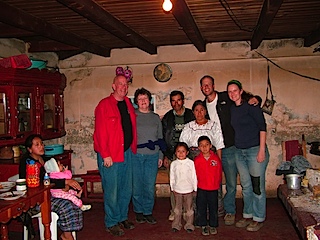 We were especially lucky that Emily’s parents got to meet Don Ximon and his family, as well. He and Nas Palas are the two elders of the village that really make our work here possible.
We were especially lucky that Emily’s parents got to meet Don Ximon and his family, as well. He and Nas Palas are the two elders of the village that really make our work here possible.
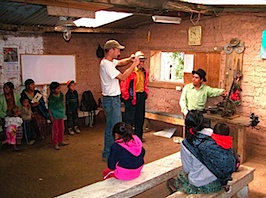 On the second day, I had a meeting with the leaders of Yulais, the nearby village where we are trying to get a construction project going. Millie stayed home with Emily, and I took Mike along. Up into the hills we climbed, until we arrived at our destination. As luck would have it, the nurse Lucia was visiting Yulais as well, giving vaccinations and weighing babies. Mike doesn’t speak any Spanish, so he nodded and smiled as I worked the crowd, introducing him to the villagers and translating their questions. They were really thrilled to see him, and the questions poured forth: “How old is he? Where did all his hair go? Why are Gringoes so big?”
On the second day, I had a meeting with the leaders of Yulais, the nearby village where we are trying to get a construction project going. Millie stayed home with Emily, and I took Mike along. Up into the hills we climbed, until we arrived at our destination. As luck would have it, the nurse Lucia was visiting Yulais as well, giving vaccinations and weighing babies. Mike doesn’t speak any Spanish, so he nodded and smiled as I worked the crowd, introducing him to the villagers and translating their questions. They were really thrilled to see him, and the questions poured forth: “How old is he? Where did all his hair go? Why are Gringoes so big?”
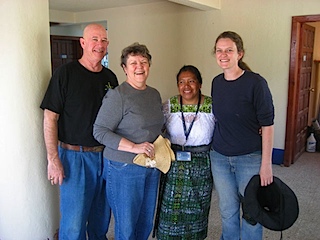 A few hours later, the meeting started to wind down. “Wow, we got out of there pretty fast,” I explained after I got the two signatures I had come for. The nurse Lucia was finishing up at the same time we were, so the three of us strolled back together. We chatted on the way, with Lucia taking occasional breaks to yell at kids playing in trees: “Why aren’t you in school?” she shouted in Q’anjob’al. They shrugged, and climbed down from the tree. That’s what’s great about Lucia; she knows what’s right, and is not afraid to push that agenda forward. And she’s known and respected by everyone, since she’s a local but also a professional, and takes care of everyone’s health needs. When we got to the health post, we called Emily and Millie down so they could meet her. She promptly invited us to her house in Santa Eulalia, to meet her son and her brother.
A few hours later, the meeting started to wind down. “Wow, we got out of there pretty fast,” I explained after I got the two signatures I had come for. The nurse Lucia was finishing up at the same time we were, so the three of us strolled back together. We chatted on the way, with Lucia taking occasional breaks to yell at kids playing in trees: “Why aren’t you in school?” she shouted in Q’anjob’al. They shrugged, and climbed down from the tree. That’s what’s great about Lucia; she knows what’s right, and is not afraid to push that agenda forward. And she’s known and respected by everyone, since she’s a local but also a professional, and takes care of everyone’s health needs. When we got to the health post, we called Emily and Millie down so they could meet her. She promptly invited us to her house in Santa Eulalia, to meet her son and her brother.
The next day, we took a microbus into town to make that happen. Mike and Millie got their chance to try the microbus the way the locals use it: 30 people in a 15-passenger van. I think they found it amusing, but were grateful that we’d chartered Mario to take us privately back south at the end of our village stay. After 40 minutes cramped quarters, we arrived at Lucia’s house and met her brother Pedro, our Q’anjob’al teacher and my best Mayan friend. He invited us in, and we had some atol with them as Ronald came over from the school next door. “Oh! I didn’t know you were here,” he said. “In the middle of class they told me to go home, and I thought I was in trouble!” We all laughed; he’s a good kid, and the thought of him doing something bad enough to get in trouble is pretty hilarious. Ronald is one of the smartest 10-year-olds I’ve met, much like Chalio, and the two of them even play together sometimes when Ronald comes to our village with his mom.
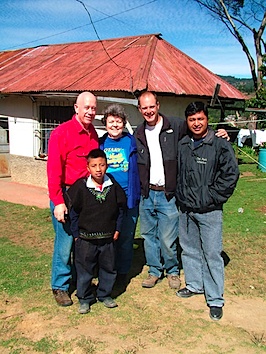 A bit into our visit, Aurelio stopped by to visit as well. He’s our counterpart in the Ministry of Health, and a really decent guy. This was a meaningful afternoon to us: Aurelio and Pedro are the two most with-it, professional, worldly, honest guys we come in contact with in our work. It also strikes me as interesting how that sort of stuff runs in families. Pedro is the brother of the nurse Lucia, a huge supporter of ours; and Aurelio is Don Ximon’s nephew.
A bit into our visit, Aurelio stopped by to visit as well. He’s our counterpart in the Ministry of Health, and a really decent guy. This was a meaningful afternoon to us: Aurelio and Pedro are the two most with-it, professional, worldly, honest guys we come in contact with in our work. It also strikes me as interesting how that sort of stuff runs in families. Pedro is the brother of the nurse Lucia, a huge supporter of ours; and Aurelio is Don Ximon’s nephew.
The last evening we spent in our village, Nas Palas and his family invited us over to eat kalnel with them. It was a reunion of sorts: Galindo was back from his first week away at college in Huehuetenango, and Reyna was home for the weekend from her job in the health center in San Rafael. “We were going to have the sheep two days from now, at the start of the town festival,” Nas explained, “but we really wanted you to have some too.” We talked late into the night, and Nas told a lot of really cool stories about the local Mayan history. They will appear in the next post.
After three nights in the village, it was time to move on. Mario showed up promptly at 6am, and whisked us away for a 6-hour drive to Lake Atitlan. After half a week of outhouses, washing in streams, and living in a wooden box, it was time for relaxation.
We’ve posted about the Casa del Mundo hotel before, so I won’t take up a lot of space here repeating myself. But it was a pretty relaxing time for all of us, and the two days we spent there were perfect: great weather, awesome views of the volcanic lake, and no work. Don’t get me wrong; I like my work, but sometimes you need a break. And a break is NOT something we ever get while we’re in the village.
The last day of their trip was spent in Antigua, the colonial capitol of Guatemala. I spent a lot more time than normal translating and answering questions, and I even learned some new stuff. For example, I didn’t realize that the Hermano Pedro church was older than the main cathedral; it was built in 1545, whereas the majority of the construction on Antigua’s cathedral occurred in the 1600s. To be honest, I am still blown away that there are 500-year-old cathedrals even IN the new world. We also went and browsed artisan markets, ate in fancy eateries, and enjoyed strolling the ancient cobblestone streets. We even passed the spot where my mom broke her arm, without incident. In all, it was a fantastic trip.
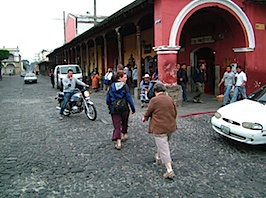 One of the things that most impressed me about my inlaws is how open-minded and flexible they were during the entire trip. Millie says, “Blessed are the flexible, for they shall not be bent out of shape.” I had never had the chance to spend so much concentrated time with them, and I was pleasantly surprised by what I learned. Not because I expected them to be a pain; it’s more because I meet so few people who are truly easygoing… and Guatemala definitely tests that part of one’s personality.
One of the things that most impressed me about my inlaws is how open-minded and flexible they were during the entire trip. Millie says, “Blessed are the flexible, for they shall not be bent out of shape.” I had never had the chance to spend so much concentrated time with them, and I was pleasantly surprised by what I learned. Not because I expected them to be a pain; it’s more because I meet so few people who are truly easygoing… and Guatemala definitely tests that part of one’s personality.
